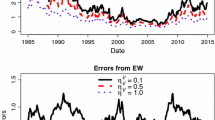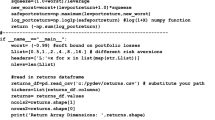Abstract
When faced with the challenge of forming a portfolio containing a risky and a risk-free asset, investors tend to apply the same portfolio weights independently of the volatility of the risky asset. This “percentage heuristic” can lead to different levels of portfolio risk when the same investor is presented with a more or a less risky asset. Using four experiments, we show that asking investors to choose the return distribution for their portfolio while keeping the exact portfolio weights unknown leads to greater similarity in levels of portfolio volatility (across different levels of risk of the risky asset) than asking investors to choose this distribution while additionally facing the portfolio weights. Higher consistency in risk taking is obtained both between and within test subjects.




Similar content being viewed by others
Notes
Experimental instructions are depicted word for word in the “Appendix”.
Alternative starting points (50:50; 2/3–1/3) were used in a pre-test and did not seem to influence general risk taking.
This is not perfectly true, as participants in the low-risk asset group would need an allocation above 100% to reach a risk-return profile similar to that of a person in the high-risk asset group investing 100% into the risky asset. However, as subjects already face a complex decision, the task is kept simple by omitting such a borrowing possibility.
As most private investors can potentially take out credits, borrowing could conceivably be allowed. However, as subjects already face a complex decision, the task is kept simple by omitting a borrowing possibility. Furthermore, in actuality investors are often discouraged from buying risky assets on credit, which could affect the results: even subjects understanding the design might be reluctant to take out credit.
References
Barberis, N., Huang, M., & Thaler, R. H. (2006). Individual preferences, monetary gambles, and stock market participation: A case for narrow framing. The American Economic Review, 96, 1069–1090.
Barr, M. S., Mullainathan, S., & Shafir, E. (2008). Behaviorally informed financial services regulation. Washington, DC: New America Foundation.
Benartzi, S., & Thaler, R. H. (2001). Naive diversification strategies in defined contribution saving plans. American Economic Review, 91(1), 79–98.
Berinsky, A. J., Huber, G. A., & Lenz, G. S. (2012). Evaluating online labor markets for experimental research: Amazon.com’s Mechanical Turk. Political Analysis, 20(3), 351–368.
Bradbury, M., Hens, T., & Zeisberger, S. (2015). Improving investment decisions with simulated experience. Review of Finance, 19(3), 1019–1052.
Camerer, C. F., & Hogarth, R. M. (1999). The effects of financial incentives in experiments: A review and capital-labor-production framework. Journal of Risk and Uncertainty, 19(1–3), 7–42.
Chevalier, J., & Ellison, G. (1997). Risk taking by mutual funds as a response to incentives. Journal of Political Economy, 105, 1167–1200.
Choi, J. J., Laibson, D., & Madrian, B. C. (2009). Mental accounting in portfolio choice: Evidence from a Flypaper effect. American Economic Review, 99(5), 2085–2095.
Clifford, C. P., Fulkerson, J. A., Bradford, J. D., and Waldman, S. (2013). Risk and fund flows, Working Paper.
Cronqvist, H., & Siegel, S. (2014). The genetics of investment biases. Journal of Financial Economics, 113(2), 215–234.
DellaVigna, S. (2009). Psychology and economics: Evidence from the field. Journal of Economic Literature, 47(2), 315–372.
DeMiguel, V., Garlappi, L., & Uppal, R. (2009). Optimal versus naive diversification: How inefficient is the 1/N portfolio strategy? Review of Financial Studies, 22(5), 1915–1953.
Dorn, D., & Huberman, G. (2005). Talk and action: What individual investors say and what they do. Review of Finance, 9, 437–481.
Dorn, D., & Huberman, G. (2010). Preferred risk habitat of individual investors. Journal of Financial Economics, 97(1), 155–173.
Ehm, C., Kaufmann, C., & Weber, M. (2014). Volatility inadaptability: Investors care about risk, but can’t cope with volatility. Review of Finance, 18, 1387–1423.
European Parliament and European Council (2004). Markets in financial instruments directive (2004/39/EC). Official Journal of the European Union 2004.
European Parliament and European Council (2009). Undertakings for collective investment in transferable securities (UCITS) directive (2009/65/EC). Official Journal of the European Union 2009.
Frijns, B., Koellen, E., & Lehnert, T. (2008). On the determinants of portfolio choice. Journal of Economic Behavior & Organization, 66, 373–386.
Gigerenzer, G., & Gaissmaier, W. (2011). Heuristic decision making. Annual Review of Psychology, 62, 451–482.
Gneezy, U., & Potters, J. (1997). An experiment on risk taking and evaluation periods. Quarterly Journal of Economics, 112(2), 631–645.
Goldstein, D. G., Johnson, E. J., & Sharpe, W. F. (2008). Choosing outcomes versus choosing products: Consumer-focused retirement investment advice. Journal of Consumer Research, 35(3), 440–456.
Goldstein, D. G., & Rothschild, D. (2014). Lay understanding of probability distributions. Judgment and Decision Making, 9(1), 1–14.
Hogarth, R. M., & Soyer, E. (2011). Sequentially simulated outcomes: Kind experience versus non-transparent description. Journal of Experimental Psychology: General, 140, 434–463.
Jacobs, H., Müller, S., & Weber, M. (2014). How should individual investors diversify? An empirical evaluation of alternative asset allocation policies. Journal of Financial Markets, 19, 62–85.
Kaufmann, C., & Weber, M. (2013). Sometimes less is more—The influence of information aggregation on investment decisions. Journal of Economic Behavior & Organization, 95, 20–33.
Kaufmann, C., Weber, M., & Haisley, E. C. (2013). The role of experience sampling and graphical displays on one’s investment risk appetite. Management Science, 59(2), 323–340.
Kaustia, M., & Knuepfer, S. (2008). Do investors overweight personal experience? Evidence from IPO subscriptions. Journal of Finance, 63(6), 2679–2702.
Laudenbach, C., Loos, B. and J. Pirschel. 2017. Recent experiences and risk taking: Trading responses to changes in the local environment. Working Paper.
Lejarraga, T. (2010). When experience is better than description: Time delays and complexity. Journal of Behavioral Decision Making, 23(1), 100–116.
Malmendier, U., & Nagel, S. (2011). Depression babies: Do Macroeconomic experiences affect risk taking? The Quarterly Journal of Economics, 126(1), 373–416.
Markowitz, H. (1952). Portfolio selection. Journal of Finance, 7(1), 77–91.
Merkle, C. (2017). The curious case of negative volatility, Working Paper.
Nosic, A., & Weber, M. (2010). How riskily do I invest? The role of risk attitudes, risk, perceptions, and overconfidence. Decision Analysis, 7(3), 282–301.
Rand, D. G. (2012). The promise of Mechanical Turk: How online labor markets can help theorists run behavioral experiments. Journal of Theoretical Biology, 299, 172–179.
Schooley, D. K., & Worden, D. D. (1996). Risk aversion measures: Comparing attitudes and asset allocation. Financial Services Review, 5(2), 87–99.
Sharpe, W. F. (1964). Capital asset prices: A theory of market equilibrium under conditions of risk. Journal of Finance, 19(3), 425–442.
Sharpe, W. F. (1966). Mutual fund performance. The Journal of Business, 39(1), 119–138.
Sirri, E. R., & Tufano, P. (1998). Costly search and mutual fund flows. Journal of Finance, 53, 1589–1622.
Thaler, R. (1985). Mental accounting and consumer choice. Marketing Science, 4(3), 199–214.
Thaler, R. H. (1999). Mental accounting matters. Journal of Behavioral Decision Making, 12(3), 183–206.
Tobin, J. (1958). Liquidity preference as behavior towards risk. Review of Economic Studies, 25(2), 65–86.
van Rooij, M., Lusardi, A., & Alessie, R. (2011). Financial literacy and stock market participation. Journal of Financial Economics, 101(2), 449–472.
Vlaev, I., Chater, N., & Stewart, N. (2007). Financial prospect relativity: Context effects in financial decision-making under risk. Journal of Behavioral Decision Making, 20, 273–304.
Acknowledgements
We thank Peter Bossaert, Christopher Hrdlicka, Annika Kasparek, Christoph Merkle, Florian Muenkel, Alexandra Niessen-Ruenzi, Andrew Siegel, Stephan Siegel, Olga Tyurina, and Stefan Zeisberger for helpful comments and discussions. We would also like to thank (seminar) participants at the Subjective Probability, Utility, and Decision Making Conference, the Boulder Summer Conference on Financial Decision Making, the Experimental Finance Conference, the Research in Behavioral Finance Conference, the Frankfurt School of Finance and Management, University of Lausanne, University of Navarra, as well as the University of Washington for valuable comments. Finally, we thank Nils Kaufmann and Janick Edinger for programming the experiment. We gratefully acknowledge research funding from the Karin Islinger Stiftung.
Author information
Authors and Affiliations
Corresponding author
Appendix: experimental instructions
Appendix: experimental instructions
Page 1 Welcome to our experiment on financial decision making. In the following, we will ask you to make an investment decision for a 5 year horizon.
After you decide, we will conduct a “financial” market simulation” to determine the 5 year return on your decision. This simulation will randomly generate a return based on the underlying distribution of the risk-free and the riskier investment, you have chosen.
This amount divided by 100 is the amount you will be paid as a bonus if you are one of the participants chosen to be paid based on your decision (you have a 1 in 40 chance of being chosen).
Page 2 Please imagine you want to invest $1000 over a 5 year time horizon. You will have the chance to invest in the following portfolio consisting of a risky and a risk free asset.
Page 3 start with the simulation, which is depicted in Fig. 2.
Rights and permissions
About this article
Cite this article
Ehm, C., Laudenbach, C. & Weber, M. Focusing on volatility information instead of portfolio weights as an aid to investor decisions. Exp Econ 21, 457–480 (2018). https://doi.org/10.1007/s10683-017-9537-0
Received:
Revised:
Accepted:
Published:
Issue Date:
DOI: https://doi.org/10.1007/s10683-017-9537-0




